
E-mail: font@focusonnature.com
Phone: Toll-free in USA 1-800-721-9986
or 302/529-1876
 |
PO
Box 9021, Wilmington, DE 19809, USA E-mail: font@focusonnature.com Phone: Toll-free in USA 1-800-721-9986 or 302/529-1876 |
The
FOCUS ON Nature Tour in
JAPAN
January 2008
"A Tour with Blakiston's Fish Owl, Eagles, Cranes, Mandarins, and More"
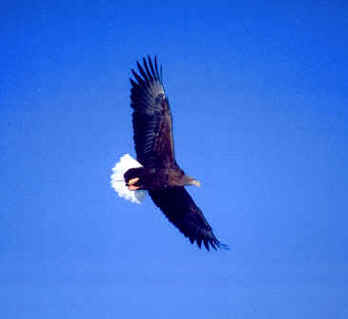
High in the sky, an adult
White-tailed Eagle
photographed during a FONT tour
Links:
List of Birds during our Japan Tour - January 2008
Cumulative List of Birds during our Japan Tours (with photos)
Rare Birds during FONT Tours in Japan
Upcoming FONT Japan Birding & Nature Tours
The following account of the FONT Jan 2008 Japan Tour was written by Armas Hill, leader of the tour:
Our 30th FONT birding & nature tour in Japan
took place January 8-21, 2008. During that
tour, again, as there have been during such tours in the past, a number of nice
birds were seen, and memorable experiences were had, as we traveled about the
countryside. Those travels were on the three main Japanese island of Honshu,
Hokkaido, and Kyushu.
Highlights were many. Foremost among them were, as always, the cranes and
the eagles on both the northern island of Hokkaido
and the southern island of Kyushu.
Many Steller's and White-tailed Eagles, and the Japanese,
or Red-crowned Cranes were enjoyed by our group on Hokkaido. On Kyushu,
we were treated to 4 species of Cranes (White-naped, Hooded, Common,
& Sandhill) and a single rare Eagle for Japan, a Greater
Spotted.
But the tour highlight that was probably the best of them all was our experience on Hokkaido
with the very big & very rare Blakiston's Fish Owl.
At dusk, one day, we were where we should have been to see this owl named after
Captain Thomas Wright Blakiston. We were ready.
Mr. Blakiston was a consul and a businessman from England who went to Japan,
specifically southwest Hokkaido, in the mid-1800's, immediately after the
"opening" of Japan to foreigners. During about 20 years that he was
there, Blakiston enthusiastically pursued an interest in describing the avifauna
and the zoological features of that northernmost Japanese island of Hokkaido. In
Japan, the owl named after Blakiston, only occurs on Hokkaido, where, due to its
habits and habitat, it is very rare. Another population, also small, occurs on
mainland Asia in Siberia.
The Blakiston's Fish Owl is very large, with a wingspan of about 2 meters
(that's 6 feet). It's been said that the female is the largest of the
world's owls. As big as 71 centimeters in length, it's larger than the Eurasian
Eagle Owl. And bigger than these other large owls elsewhere in the world:
the Verreaux's Eagle Owl, of Africa, up to 65 centimeters,
the Pel's Fishing Owl, of Africa, up to 61 centimeters,
the Shelley's Eagle Owl, also of Africa, also up to 61 centimeters,
and the Tawny Fish Owl of southern Asia, up to 58 centimeters.
As noted, the huge Blakiston's Fish Owl is also very rare. In Japan (Hokkaido
only), there may be population of 100 to 120 birds. On mainland Asia, there
may just be a few hundred.
So, as I said, late that day on Hokkaido, as darkness was falling, we were ready
to see it. We had already experienced, the previous day, a flock of over a
hundred Red-crowned Cranes walking about in stately fashion on the snow.
Earlier, during the same day that we were in place to see the owl, we had seen
some magnificent Steller's Sea Eagles. That is certainly an appropriate
adjective for that huge and striking bird that comes to Hokkaido during the
winter from the Siberian wilderness to the north. And so, yes, even we had
already seen some wonderful sights, we were ready for the third part of the
Hokkaido "Avian Big 3", the owl.
As ready as we were, however, that day it was not to be. As we waited, and as
the sky got darker, a Ural Owl flew by us. And it was the only owl that
we saw that day.
Therefore, we opted to stay an extra day on Hokkaido, which was fine as that
island does offer some of the best wintertime birding anywhere. During our
additional day, we continued to have good experiences, again with Steller's
and White-tailed Eagles, and with a fine assortment of waterbirds (such
as Whooper Swans, various ducks, and gulls). The
settings in which we saw these birds added to the experience. The winter scenery
was superb.
As the day ended, we were back again at the same place where we had hoped to see
the Blakiston's Owl the previous day. Would it be different?
Even though we stuck with pretty much the same strategy, it was quite different.
All of a sudden, a big Blakiston's Owl appeared, near us, on the top of a
utility pole. Then, there was another! A pair of the owls was with us, a female
and a male (the male is large, but female is larger). We got out of our
vehicle and stood quietly outside. Both of the owls flew right above us, with
their big forms against the beautiful twilight sky. The owls, though, to us,
were more beautiful. To be by such creatures was a thrill. Like the eagles, they
were also magnificent! But, the experience was all the more outstanding, as we
had missed the bird the day before.
The owls stayed with us, as they were perched nearby on posts and
branches. We could see well their features - their feathers, their tufts, their
eyes, their talons. And we heard them too. The pair called in duet, with the
voice of one deeper than than that of the other.
We were so glad that we had opted to stay that extra day on Hokkaido.
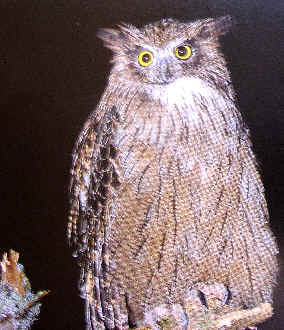
Blakiston's Fish Owl
With our January '08 experience, the Blakiston's Fish Owl has continued
to be found during every late-fall & winter FONT Japan tour. Our record is
now 19 sightings during 19 such tours.
Seen during every FONT tour in Hokkaido, Japan,
has been the Red-crowned Crane, the second rarest of the 15 species of
the world's cranes, after the Whooping Crane of North America. Mention has
already been made that we saw over a hundred of these tour and elegant birds
during our stay in Hokkaido, as they walked about on the snow. We also observed
them as they flew and as they fed. We watched and listened as they made their
loud calls, as cranes do. We saw them occasionally dance about on the snow.
Although during winter the cranes form flocks at places where they feed, it was
apparent that in the group of birds, as we watched, that there were paired
adults and some adults still with their young birds of the year.
We had a very nice afternoon with the cranes.
A young man at the "crane interpretive center" gave us (in English)
a tremendous amount of information about the birds.
An older man, at about 2pm, wandered out on the snow among the cranes, and as
he's done for years, he threw small fish onto the ground. The cranes there also
feed on some grain, but it was apparent that they looked forward to the man's
daily walk with the fish. Prior to it, there was, among those birds, notable
anticipation (even though none of the older birds were wearing a watch, and
none of the younger birds had a mobile phone with a digital clock!).
Other birds in the area also anticipated the afternoon feeding. White-tailed
Eagles appeared, as if on cue. They swooped down to the ground, snatching up
some of the fish. Black Kites did as well. Whooper Swans, that
were on the snowy ground near the cranes, flew away when the man, with
the bucket of fish, entered the field.
The cranes, by the way, held their own, with the eagles. Both, of course, are large, but we could see that the cranes were
not intimidated by the eagles.
No Steller's Sea Eagles came in to the afternoon spectacle of birds at
feeding time, but both adult and juvenile birds were seen, as they flew by.
Large-billed Crows, when seen on their own, appear large - not only their
bills being so, but overall. However, when in the company of eagles, cranes,
kites, and swans, the crows that were on the scene seemed
rather small.
It was a wonderful afternoon for us, during that day in Hokkaido, at the crane
site.
And it was particularly nice when we reflected that the beautiful creature that
we were seeing, the Japanese Crane, was at one time so very close to
extinction. Back in the 1920's, the total population of Red-crowned,
or Japanese, Cranes in Japan was only about 20 individuals, all of them
in southeastern Hokkaido. Today, in Japan, they are still only in that one part
of the country, but now the population numbers about 1,000 birds. They are
Hokkaido residents, that throughout much of the year occur mostly in marshy
places where they breed. Pairs have their sizable territories. In the winter,
they form flocks (as we saw during our tour) at a few (3 or 4)
particular places. It has been the winter-time feeding, over the years, of grain
and fish, as noted above, that has caused the increase in the population, also
just noted, during recent decades. Another significant factor has been the
removal of high tension lines in areas frequented by the cranes.
Just about 15 years ago, at the time of the first FONT tour in Hokkaido, Japan,
in 1994, the total number of Japanese, or Red-crowned, Cranes was
557. As of this year, that population has nearly doubled. In 2006, the number of
these cranes counted in Hokkaido was 1,013. When I first visited Hokkaido in
1982, and saw my first Japanese Cranes, the population was a mere 320
birds. How good it's been that the bird's numbers have increased since! And, for
me, personally, each time that I've seen them since, it's really been a thrill.
Also thrilling, during each visit to Japan, has been every encounter with cranes
in the winter at the opposite end of country, on the southerly island of
Kyushu. Again, in January 2008, we had a good day there with the
thousands of cranes that come each winter from mainland Asia. It's about
12,000 cranes that come annually. Of them, just over 10,000 are Hooded
Cranes. About 2,000 of them are White-naped Cranes. Both are nice to
see, but with their elegant appearance, the White-naped Cranes are
especially so.
During the one census conducted of the Kyushu cranes during the '07-'08 winter,
10,973 Hooded Cranes were tallied. That's up a bit - and that's good, as
nearly all the world's Hooded Cranes winter in that one portion of
Kyushu.
The tally of White-naped Cranes, during that census, was 1,019. That's a
bit down. But a few more may have come after that count done in December. A
second and third winter census was not conducted in early '08 due to bad
weather. But during the day that we were there, in January '08, the weather was
wonderful - as was our day.

During our
January '08 Japan tour, we had a good group,
with tour participants from California USA & Australia,
and we also met, as we have previously during our tours in Japan,
some nice local people along the way.
One such person is the man (in the photo above)
who feeds the Red-crowned Cranes in Hokkaido (in the photo below).
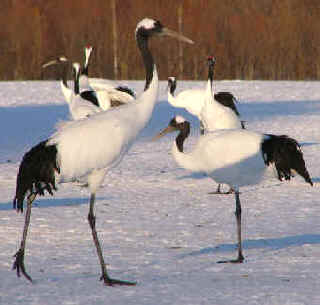
Another such
person is the man (at left, in the photo below)
who operates a restaurant in Kyushu
where the cranes are there (in the bottom photo).
FONT tour leader, Armas Hill (at right, in the photo below)
has been to that restaurant numerous times.


A group of White-naped Cranes on Kyushu.
During our time
with the cranes on Kyushu, we saw 4
species in that family. In addition to the Hooded and the White-naped,
we saw a Common Crane and 2 Sandhill Cranes. Every year, during
the decade and a half that we've been seeing cranes on Kyushu, a few stragglers
of these two species have been present. Both species come with the Hooded
and White-naped Cranes from mainland Asia.
The Common Crane breeds at various places across the wide land expanse of
Eurasia. There are two subspecies, basically one westerly, in Europe, and
another further east, in eastern Asia. The second of these is the subspecies
that occurs in Japan. It was described as a subspecies in 1894, over a hundred
years after the nominate, or western, race was described by Linnaeus in Sweden,
when the modern-day system of avian classification began in 1758.
The Sandhill Crane is thought of as a North American bird, and that it
is, but a fairly sizable number do nest each year in Asia, in eastern Siberia. Nearly
all of those birds, after breeding, fly eastward to North America. Actually, in
general, those that nest the furthest west in Eurasia migrate the furthest south
in North America, even as far south as Mexico. Every year, however, a couple Sandhill
Cranes come south to Japan to spend their winter - not quite as
"outcasts", but usually toward the edge of the large crane flocks.
The Japanese name for the Sandhill Crane is "Kanada-zuru".
"Zuru" is a word for
"crane". Of course, Sandhill Cranes are quite numerous in Canada,
during their nesting season. However, those Sandhill Cranes seen about annually
in Japan have most likely never been in that North American country. Two
Sandhill Cranes were present with the other cranes in Kyushu in January 2008. We
saw both. They were not together.
Not in Kyushu, Japan, during the winter of '07-'08, were either the rare Siberian
Crane or the Demoiselle Crane. Both have occurred, and have been seen
during FONT tours, in recent years. But not this time.
After we enjoyed most of a day with the masses of cranes on Kyushu, we
traveled a few kilometers south with the intention of seeing a rarity in Japan,
a Greater Spotted Eagle. We had learned, at lunch, from the man in the
photo above, at the restaurant, that a single bird was present there again,
having been seen just a day or two earlier. From him, we got directions, and
even though we didn't have much time, we were on our way.
The plan was to drive the 40 or so kilometers to the appropriate place and,
during a short allocation of time, see the bird.
The Greater Spotted Eagle is a globally threatened species, classified as
"vulnerable" by the Birdlife International. Its range is vast, across
Eurasia, but there are not many birds. A recent estimate is of less than 10,000
adults. The breeding range is large, but highly fragmented. The species winters
in over 30 countries, and occurs as a vagrant in another 20 countries, including
Japan. The single, wintering bird which we sought in Kyushu may well have been
the only Greater Spotted Eagle existing in Japan when we saw it!
But I'm getting ahead of myself. Yes, we did see the eagle. After the
drive, we were nearly sure that we were at the right place, but we wanted, as
the afternoon was waning, to be absolutely sure. So we stopped at the post
office, in the little town, to ask (bearing in mind, of course, that I speak
mostly English, and the postal employees there speak mostly Japanese). But
it was "no problem", as "they say", in that regard. When I
inquired, with a bird book and body language, they immediately said "Washi",
the Japanese word for eagle. All of the postal employees knew about the
bird.
As I was in the post office, a car pulled up next to our vehicle in the parking
lot. The people in the car also knew about the "Washi",
and they told us to follow them to the proper spot to observe it. And that we
did, and then within seconds, we saw the large bird, soaring about in the sky
above a wooded ridge.
Actually, some of our group, had already spotted it from the post office parking
lot, but from there it was further away. Thus, the Greater Spotted Eagle
was just that - "spotted" - and it was one that was
"greater" as well, as we only had but a few minutes. Being late in the
afternoon, after 3:30, with the thermals over the hills disappearing, it was
good fortune to have the fine look that we did of the rare raptor for about 10
minutes, as flew about in the sky.
During two previous FONT tours, we had seen the Greater Spotted Eagle,
actually at the same place. But that was back in the 1990's. Yes, the place was
the same, but was it the same individual bird? For a few years, it's been said
that a single bird has wintered there. But how long does it live? In a nice new
Japanese bird book (in English), there are photos of the Greater
Spotted Eagle, both adult and immature birds, and both said to have been
photographed at the place where we were in Kyushu.
Our quick visit was fun - to the little town where "everyone" knew of
the eagle from Asia that comes each winter to the nearby hills. Again, it's
known there as the "Washi". The
complete Japanese name of the bird is "Karafuto-washi".
That of the White-tailed Eagle that we saw well in good number on Hokkaido
is "Ojiro-washi". That of the Steller's
Sea Eagle, that was so great for us to see on Hokkaido as we did, is "O-washi".
I think that's because whenever one sees that species well, one can't help
but utter "O" something - usually "Oh, my!"
"O-washi" is a great name for a
great bird. Steller's Sea Eagles are magnificent and impressive creatures
to watch. Not only are they very big, and with a striking plumage, and with a
huge yellow bill, they are truly symbols of the wild north. All of those that
come to Hokkaido in Japan in the winter are from a rather restricted area of
eastern Siberia, where they breed. Overall, the species is not common, as its
estimated total population is said to be only about 5,000 birds and declining.
It was nice during our January '08 tour, to see 3 species of eagles, or
"Washi"s, once again, as we
did in Japan twice before, back in the last decade, when we also then saw the Greater
Spotted.
(A note: During the FONT tour in Japan, just prior to Jan '08, in Dec 2007, we
were fortunate to see 3 "big raptors" all on Hokkaido: the 2 Eagles,
the White-tailed and the Steller's, and another large perched bird
- a Mountain Hawk-Eagle.
The female that we saw, of the latter, was big. Females are about 20 per cent
larger than males. And the Japanese race is about 10 per cent larger than the
race on mainland Asia.
The length of the female Mountain Hawk-Eagle, in the same genus as the Ornate
Hawk-Eagle in Latin America. is as much as 84 centimeters. That of the
female White-tailed Eagle is 92 centimeters. That of the Steller's Sea
Eagle is up to 105 centimeters. The length of the Greater Spotted Eagle,
by the way, is as much as 71 centimeters.)
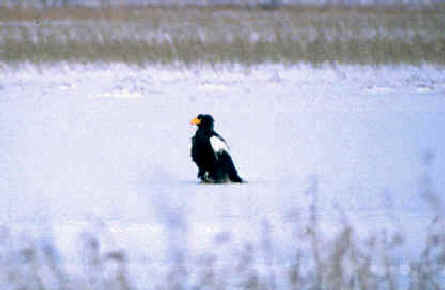
A Steller's Sea Eagle, out on the ice, in Hokkaido
Many of the birds
already noted in this narrative have been the "big ones", such as the eagles,
cranes, and the owl. But during our January '08 Japan Tour, more of
the smaller birds were seen than usual during on time on the northern island of Hokkaido.
Generally, not many such species, nor many individuals, are seen there in the winter,
particularly away from the coast. But in the "Passerine
department", aside from the Corvids (the 2 species of crows,
the Raven, and the Eurasian Jay), we encountered
over 20 species of smaller birds as we traveled about Hokkaido.
Notable among them were some flocks of Bohemian Waxwings, along with more
Dusky Thrushes than usual, Asian Rosy Finches (at a few
places), and a large flock of Common Redpolls, with about 200 of them
in that one flock in some bushes and trees at the edge of a large farm field.
Also notable, and unexpected, was a single Eurasian Skylark with that
flock of Redpolls. It was first Eurasian Skylark ever for us in
the winter in Hokkaido. We assume that one bird came from further north, in
Siberia, and that it was not a bird of the Japanese race.
Also, among the smaller birds for us in Hokkaido, was a single White Wagtail
at a rivermouth along the coast, and a flock or two of Grey-capped
Greenfinches (a bit unusual) on a coastal barrier island, where also, by
some homes, there was a single Rustic Bunting. The Rustic Bunting,
by the way, during our tour was therefore one of handful of birds seen on all
three of the islands that we visited: Honshu, Kyushu, and Hokkaido. That's
happened for us before with that species, but it's unusual.
Also in the small-bird category, the Brown Dippers that we saw on
Hokkaido were expected, as were the various Tits: the Great, Marsh,
and Varied, along with the Eurasian Nuthatch (a pale race on
Hokkaido), and the Brown-eared Bulbul. The last of these (like the
Rustic Bunting) was seen during our tour on "all 3
islands" as were the Dusky Thrush and Eurasian Tree Sparrow.
But that's to be expected.
In the woods, not really unexpected, but nice to see, were a number of Hawfinches
and Bramblings.
Hokkaido is a good place for woodpeckers. It's the only island in Japan
with the Grey-headed Woodpecker that we saw. Also seen were the Great
Spotted Woodpecker and the Japanese Pygmy Woodpecker. The Black
Woodpecker (only in Japan on Hokkaido) was heard.
Japan, in the winter, is a wonderful place for waterbirds, one of the
best anywhere in the world. About 30 species of waterfowl winter in
Japan, totaling several million birds. During our January '08 tour, we saw most
of the species, and, indeed, many individuals.
Reference has already been made here to the winter-time feeding of the cranes
in Hokkaido, with some other bird species also partaking in the banquet. Such
feeding of birds has, for years, been a rather characteristic Japanese feature,
and continues so today.
On the main Japanese island of Honshu, at
the beginning of our tour, we visited a small pond in the countryside that in
the winter is filled with waterfowl, mostly ducks, but also some Whooper
Swans. During previous FONT tours, we had seen a few Baikal Teal there,
but there was no such good luck for us there this time. Years ago, the Baikal
Teal was a common winter visitor in Japan. During recent decades, however,
that species has drastically declined in Japan, with it now being in just a few
favored areas.
At the small pond, however, we did have the good fortune to see closely some Falcated
Ducks, another species of waterfowl with the drake being a beautiful
creature.
The feeding of birds just alluded to a moment ago takes place at that pond every
afternoon. The feeding-time is 3pm, and, at that time, we were there. When those
who throw the grain onto the water do so, there was bedlam among the birds,
including not only noisy swans, but an assortment of ducks. In
addition to the Falcated Ducks, there were many Northern Pintails
and Eurasian Wigeon, along with some Tufted Ducks and Common
Pochards. There were some other species too, and 3 drakes that appeared to
be American-Eurasian Wigeon hybrids.
Some of this mass of ducks were so enthusiastic about eating, that they
literally, and quickly, flew around us and other people at the edge of the pond
in their fervor.
And it's interesting that these are really wild ducks - having come from
places to the north, mostly in Siberia, that are truly quite wild, and where
there are very few people. During most of their year, they probably encounter
nearly no humans, and when they do, in Japan in the winter, they are people who
feed them - every day at 3pm.
Another thing interesting, that we couldn't help but notice there at the pond,
when the birds were being fed, was that the large number of Mallards
there kept their distance, out on the water. They did not join in the feeding
frenzy. Those Mallards appeared to be more "on the wild side" than
many seen at other places in the world.
Further north, on colder Hokkaido, there
were other places where we visited that bird-feeding was a daily activity.
On a large lake, away from the coast, there were dozens of Whooper Swans.
As just noted, Hokkaido is colder than Honshu, but it (Hokkaido that is)
can be even colder than it was for us in January '08.
It was a beautiful day for us at that lake with the Whooper Swans, with a blue
sky, and nearly no ice. The lake can be (and has been for us during other tours)
nearly completely frozen.
Famous photographs of the Whooper Swans on open water, in the mist, and with the
snow, have been taken at that lake. Those hearty swans are only there in the
winter. Their nesting grounds are in Siberia, as are those of so many of the
birds that we see in Japan during our winter tours.
When the swans at the lake are fed, they call. And they call loudly. I guess,
more aptly, they "whoop", as, after all, they are "Whoopers".
When I hear them, I wonder (as odd it may be to do so) how it is that the
swans of Eurasia are called "Whooper", while the cranes in North
America, that give their loud call, are called "Whooping".
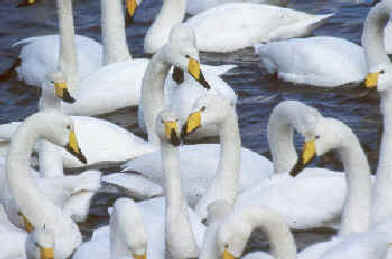
Whooper Swans
At another
bird-feeding spot in Hokkaido that we visited along the eastern seacoast, there
were also Whooper Swans, also loudly calling, and a number of ducks.
The composition of the waterfowl was different than what there was at the small
pond on Honshu. At the Hokkaido spot, there were, in closely, Common
Goldeneye and Greater Scaup, in addition to Northern
Pintails and Mallards.
The spot for popular for parents, bundled in clothing, to bring their children,
smaller people also bundled in clothing, on a holiday, actually "Children's
Day". As the bird-feeding was going on (it seemed continuous at
this cold Hokkaido location), there was constant commotion among the birds.
In addition to the swans and the ducks, there were Gulls,
with Glaucous, Slaty-backed, and Vegas close at hand. I couldn't
help but think of how in North America, birders would travel to get a look, even
at a distance, of these birds, and that there, at this birdy Hokkaido spot, we
could nearly touch them.
Nearby, on branches in some bare trees (and not within touching-distance), there
were some White-tailed Eagles. Again, for us, we were at quite a place.
Some species of ducks just don't come in to feeding - ever. Along
that eastern coast of Hokkaido, always in the surf, there were Harlequin
Ducks. Really no species of waterfowl is as boldly and colorfully patterned
as the male Harlequin, That day, we saw many - scores of them.
Beyond the surf, we saw numerous scoters. Most were American Scoters,
with the males having an all-black plumage, and an orange bill. Some were White-winged
Scoters. It's interesting that while most of the Japanese waterfowl are
of the Eurasian ilk, the two species of scoters are, instead, those of
North America. The White-winged Scoter is a regional subspecies of the North
American bird, called the "Stejneger's White-winged Scoter",
named after one of the first western ornithologists to study Japanese birds,
back in the nineteenth century.
Like the Harlequins and the Scoters, the Mergansers never
come in to where the people feed the birds. Along the eastern Hokkaido coast,
there were both Common and Red-breasted Mergansers.
At a particular place I knew to be good for another merganser, the Smew,
we saw a pair. But it took some doing. The river where I've seen them in the
past was frozen solid, all the way to the ocean. But nearby, on the ocean
itself, in the surf, the bright, mostly white, with some black, male was seen
riding the waves with the red-capped female by his side. The pair was among a
group other mergansers. When a White-tailed Eagle flew by in the sky
above, the two Smews were the first ducks to fly away.
Many of the waterfowl species during our tour have now been noted. But a
couple more notable species remain to be mentioned, one on Hokkaido, and one on
Kyushu.
Probably the most exquisite of all the ducks we saw was the Long-tailed
Duck. At a Hokkaido harbor, and with beautiful afternoon light shining upon
it, a male Long-tailed Duck, close to us on still water, was superb. Even though
there were so many extraordinary sightings during the tour, it was thought, at
the time, that this was one of the best. What a brilliantly beautiful bird it
was!
That late afternoon light in that part of Hokkaido was truly wonderful. It's a
place on this Earth where the air is really so clean, being as far as it is from
any pollution. And so, in that cold and clear environment, the features of the
sky, both by day and night, can be vivid. In between, at twilight, the colors
above us and around us were marvelous.
On the southernmost Japanese island that we visited, Kyushu,
there was the other notable species of waterfowl of our tour. Along a
particular river there, we saw, and yes - we enjoyed seeing, the Mandarin
Ducks. All of the adjectives that have already been used in this narrative,
in relation to waterfowl, can be used again pertaining to the Mandarin:
"brilliantly beautiful; boldly and colorfully patterned; and
exquisite".
"Mandarin", itself, is from the Sanskrit word
"mantrin", meaning "counselor".
In the mid-1500's, that word was applied to Chinese officials, as a term used by
foreigners to describe the handsomely attired senior officers of the Chinese
government.
The duck, itself, is truly of the "Far East". Its native range
is only in easternmost Asia: in not just China, but further north, breeding in
the Russian Ussurland and Kuril Islands, and in northern Japan.
The Mandarin Duck has been known as the "pearl of
Manchuria". In Russia, it's known as "Manadarinka".
It's called "Yuen Yang" in
Chinese, while in Japanese it's called "Oshidori".
In Japanese art, as early as the 8th Century, the Mandarins were depicted, as
they have been since on screen paintings, showing faithful males and females
together.
While the Japanese, or Red-crowned, Crane in Japan symbolizes
happiness and longevity, the Mandarin in Japan represents the enduring
qualities of loyalty and fidelity. The Mandarin drake and hen have been believed
to be strongly monogamous.

A Mandarin drake & hen
In China, nowadays, very few Mandarin Ducks are to be found in the
winter. But, that's not the case in southern Japan, and particularly on Kyushu.
A few years ago I found that during the winter along the particular river,
referred to above, in southeastern Kyushu, there were a least a few thousand Mandarin
Ducks, along the upper reaches of that river in the wooded hills. The
species was the prevalent, and, at some places, the only species of duck along
that stretch of the river. And I found that those Mandarin Ducks were about as
"wild" as ducks could be. The small groups of ducks, along that river,
would immediately fly away, as people got out of a vehicle, on the road at a
long distance from the ducks that were either swimming on the river or tucked on
and under the branches by its edge. It happened every time, and the birds give
would their distinctive calls as they flew.
These were not birds such as those in city parks. We used to visit the Mejii
Shrine in Tokyo to see the Mandarins
there at a pond in the park. But seeing the "wilder Mandarins", in
large numbers, along the Kyushu river, has
been so much more of an experience.
Those ducks in Kyushu may come each winter from the wilder areas of mainland
Asia - in Ussurland, or from those northerly Kuril Islands. Or, maybe, they come
from northern Japan. Wherever, they come from, there are many.
A census of Mandarin Ducks wintering in Japan in 1992 tallied a total of
about 20,000 birds. The figures from that annual census in 1995 give the number
of wintering Mandarins in the Miyazaki Prefecture of Kyushu as 796 birds.
The Kyushu river we've visited for the Mandarins is in that Miyazaki Prefecture.
(A Japanese prefecture is rather like a US state.)
But the 800 or so birds just given for the entire prefecture must be a low
figure, as along that one river, during one afternoon, during one of our tours,
we counted about 3,000 Mandarin Ducks - and that was without doing, in any way,
what would be a proper census.
It was wonderful to see Mandarin Ducks, along that Kyushu river, again,
during our January 2008 tour! We didn't tally as many as 3,000, but we saw quite
a few. Due to some construction along the riverside road, that would have caused
us a significant delay, we didn't go as far upriver as we normally have.
Downriver, along that river in southeastern Kyushu. however, we saw, during our
January 2008 tour, some other wonderful birds. Near where the river flows into
the Pacific Ocean, there were both Black-faced and Eurasian Spoonbills.
The combined flock, with both species, was about 10 birds. Both Spoonbills
occur in Japan only in the winter. The Black-faced Spoonbill is one of
the rarest birds in the world, with a total estimated population of about 700
individuals.
A bird rare for Japan was also seen during our January 2008 tour by the mouth of
that Kyushu river. A single Pied Avocet was there, and with it, there was
a single Black-winged Stilt. Both the Avocet and the Stilt
were "new birds" for FONT for Kyushu, being numbers #196 & #197
for us for that island.
That was how we ended our tour. At the beginning of it, back on the main
Japanese island of Honshu, we birded one day
along another river. That day was a good one for us, there, for raptors.
We saw a nice number of Harriers, of 2 species: the Eastern Marsh,
and the Northern.
They were in addition to numbers of Osprey, Black Kites, a Peregrine
Falcon, Common Buzzards (the endemic Japanese subspecies, japonicus),
and a single hovering Rough-legged Buzzard (as it's been known in the
Old World). The Rough-legged Hawk (as it's been known in the New
World) was a "new bird" for FONT for Honshu, #302 for us for that
island.
Near where that river in Honshu flows into the Pacific Ocean, a small Japanese
city is a major fishing port. And during the winter, by where the fishing boats
dock riverside, there are huge numbers of gulls. We could get close to
them there, as, in addition to being on the water, on long concrete walls, and
in the air, the gulls were near us on boats, the payment, and rooftops. We saw,
during our afternoon there, 7 species of Gulls in an variety of plumages:
Vega, Black-tailed, Common Black-headed, Common (or Mew),
Slaty-backed, Glaucous, and Glaucous-winged. Perhaps the most
interesting observation was of a group of about 20 Common Gulls (of
the "Kamchatka race") in a tight flock, as they
floated in the air just above the river (so low to the water in fact that
their dangling feet were touching it). When doing so, the birds dipped their
bills into the water as they fed apparently on very small fish. The gulls
appeared, in unison, to be walking on the water much as storm-petrels appear to
do.
Not storm-petrels, but some gulls were seen during our pelagic trip
onboard a large ferry-boat from Honshu to Hokkaido. It was an overnight
trip, continuing as we traveled north on the Pacific Ocean during much of the
next day. We've done such a trip many times, often seeing numerous seabirds, but
unfortunately this time, there were not many birds. The boat itself was fine,
and it really was nice experience to ride on the ocean toward Hokkaido.
But, just a few gulls of various species were to be seen, along with the most
pelagic of gulls, the Black-legged Kittiwake. We saw a couple hundred of
them. The previous month, during our December '07 tour, from the ferry we saw
some Laysan Albatrosses. Not so, for us, in January '08.
The previous year, in January '07, from the ferry we saw numerous alcids: murres,
murrelets, auklets, guillemots, and the like. Again, it was not so, for us. In
fact, in January '08, not a single alcid was to be seen, even though we looked
and looked.
But we were able to look ahead - to our good birding, that we certainly were to
have, on the island of Hokkaido, with the cranes,
eagles, and the owl.
It was on Hokkaido where we saw the 4 mammals of the tour: Red Fox, Red
Squirrel, Sika Deer, and Harbor Seal.
For sure, it wasn't
just the birds, told of here, that made our January '08 the good tour that it
was. The tour was also as enjoyable and interesting as it was due to our contact
with the Japanese people and their culture.
At night, we either slept on a bed, or on a tatami,
a mat on the floor.
In our hotels, we could wear a robe known as a yukata.
When we bathed, we used the O-furo, or
"hot bath".
Our traditional Japanese towel was known as a tenugi.
At meals, we ate either with western utensils, or with O'hashi,
chopsticks.
Sometimes we had our meals at a general-menu restaurant, known as a shokudo,
with either Japanese or Western style dishes. Japanese food included various
noodles, and those of us who wished to do so had raw fish and other fresh
seafoods.
Other Japanese food included:
tempura (seafood and vegetables dipped in
a batter, and deep-fried in vegetable oil),
yakitori (chunks of chicken and onion
charcoal broiled on skewers and dipped in sauce),
tonkatsu (pork or other meat, breaded and
deep-fried)
katsudon (cutlet with egg over rice in a
bowl)
kamameshi (steamed rice in fish bouillon, seasoned with soy sauce,
and laced with some bits of chicken, beef, or pork, and mushrooms, bamboo
shoots, peas).
Bowls of rice were topped with such things as pork, beef stew, curry-flavored
stew, and eggs were cooked with a slice of chicken, onions, and other vegetable
tidbits.
Among the specialties we ate there were: Sweet potatoes, rice crackers (senbei),
and chicken on a stick (yaki tori).
And of course, there was tofu and tea (green tea, that is).
And, lastly, it was how we traveled, on "back roads" into the towns,
villages, and in the countryside, more often than not away from the cities, that
made the tour for our group, very much the all-encompassing experience that it
was.